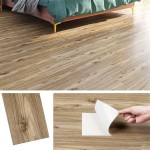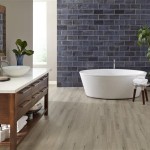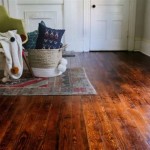Laminate Flooring That Looks Like Real Wood: A Comprehensive Guide
Laminate flooring has undergone a significant transformation in recent years, evolving from a budget-friendly alternative to a sophisticated and increasingly realistic substitute for hardwood. The advancements in manufacturing techniques, particularly in high-resolution imaging and surface texturing, have enabled laminate flooring to convincingly mimic the appearance of various wood species, grains, and finishes. This article provides a detailed examination of laminate flooring that replicates the look of real wood, discussing its construction, advantages, disadvantages, aesthetic qualities, and selection criteria.
Laminate flooring comprises several layers bonded together under high pressure. The base layer, often referred to as the backing or stabilizing layer, is typically made of melamine or phenolic resin. This layer provides structural stability and resistance to moisture. Above the base layer is the core, usually constructed from high-density fiberboard (HDF) or medium-density fiberboard (MDF). The core layer contributes to the flooring's overall strength, impact resistance, and dimensional stability. The decorative layer, also known as the image layer, is a high-resolution photograph of real wood. This layer is crucial in achieving the desired aesthetic. Finally, the wear layer, a transparent coating of aluminum oxide or melamine, protects the decorative layer from scratches, stains, and fading. The thickness and composition of the wear layer directly affect the flooring's durability and lifespan.
Understanding the Manufacturing Process: How Realism is Achieved
The realism of wood-look laminate flooring is primarily achieved through advanced printing and texturing techniques. High-resolution digital images of actual wood planks are used to create the decorative layer. These images capture the intricate details of wood grain, knots, and color variations. The printing process employs sophisticated inks and printing technologies to reproduce these details with exceptional clarity and accuracy. Embossed-in-register (EIR) technology is a particularly important advancement. EIR technology synchronizes the surface texture with the printed image. This means that the texture follows the grain patterns visible in the image, creating a tactile experience that closely resembles the feel of real wood. Without EIR, the texture might be uniform across the plank, which detracts from the realistic appearance.
Further enhancing the realism is the use of varying plank widths and lengths. Traditional laminate flooring often featured planks of uniform size, which could make the floor look repetitive and artificial. Modern laminate flooring, however, often incorporates planks of varying widths and lengths, mimicking the natural variations found in hardwood floors. Beveled edges, which are slightly angled edges on the planks, also contribute to a more realistic look by creating subtle definition between the individual planks.
Color variation plays a vital role in mimicking real wood. Natural wood exhibits a range of colors and tones due to variations in age, growth conditions, and exposure to sunlight. High-quality laminate flooring incorporates these color variations within the decorative layer to create a more authentic and visually appealing look. The use of matte or low-gloss finishes further enhances the realism by reducing glare and mimicking the natural appearance of oiled or waxed wood floors.
Key Advantages of Wood-Look Laminate Flooring
Wood-look laminate flooring offers several advantages over traditional hardwood flooring, making it an attractive option for many homeowners. One of the most significant advantages is its cost-effectiveness. Laminate flooring is generally less expensive than hardwood, both in terms of material costs and installation expenses. This makes it a budget-friendly choice for homeowners looking to achieve the aesthetic of hardwood without the associated price tag.
Durability is another key advantage. The wear layer of laminate flooring is designed to withstand heavy foot traffic, scratches, and stains. This makes it a suitable option for homes with children, pets, or high-traffic areas. Laminate flooring is also resistant to fading from sunlight exposure, allowing it to maintain its appearance for many years. Many laminate floors carry warranties that extend to decades.
Ease of maintenance is a further benefit. Laminate flooring is typically easy to clean with a damp mop or vacuum. It does not require the specialized cleaning products or maintenance routines associated with hardwood floors, such as sanding, refinishing, or waxing. The stain-resistant properties of the wear layer also make it easy to clean up spills and messes.
Installation is generally simpler than installing hardwood. Many laminate flooring products feature a click-lock system, which allows the planks to be easily connected without the need for nails or glue. This simplifies the installation process and makes it a viable option for DIY projects. However, proper subfloor preparation is essential to ensure a stable and level surface for the laminate flooring.
Finally, laminate flooring offers a wider range of design options compared to natural wood. Since the decorative layer is a printed image, manufacturers can replicate the look of various wood species, grains, and finishes, including exotic woods that may be difficult or expensive to obtain in their natural form. This allows homeowners to achieve a desired aesthetic without the limitations of natural wood.
Potential Drawbacks and Considerations
Despite its many advantages, wood-look laminate flooring also has some potential drawbacks that should be considered. While high-quality laminate flooring offers excellent durability, it is not as durable as solid hardwood. The wear layer can be scratched or damaged by sharp objects or heavy furniture. While scratches can sometimes be repaired with specialized products, severe damage may require replacing individual planks.
Laminate flooring is generally water-resistant but not waterproof. Excessive moisture exposure can cause the core layer to swell or warp, leading to damage. Therefore, it is important to avoid using laminate flooring in areas with high moisture levels, such as bathrooms or laundry rooms, unless the product is specifically designed for such applications. Spills should be cleaned up promptly to prevent water damage.
While advanced printing and texturing techniques have significantly improved the realism of laminate flooring, it may still not perfectly replicate the look and feel of natural wood. Some discerning observers may be able to distinguish between laminate flooring and hardwood flooring, especially in certain lighting conditions or at close range. The sound of walking on laminate flooring can also differ from the sound of walking on hardwood, which can be a consideration for some homeowners.
Another factor to consider is the potential for off-gassing. Some laminate flooring products may emit volatile organic compounds (VOCs), which can affect indoor air quality. To minimize this risk, it is important to choose laminate flooring products that are certified by reputable organizations, such as FloorScore, and ensure proper ventilation during installation.
Finally, the resale value of a home with laminate flooring may not be as high as a home with hardwood flooring. While laminate flooring can be an attractive and cost-effective option, some homebuyers may prefer the perceived value and prestige of natural wood.
When selecting wood-look laminate flooring, it is important to consider several factors to ensure that the product meets your specific needs and preferences. The thickness of the wear layer is a crucial consideration, as it directly affects the flooring's durability and lifespan. A thicker wear layer will provide better protection against scratches, stains, and wear. The AC (Abrasion Class) rating, which ranges from AC1 to AC5, indicates the flooring's resistance to abrasion. Higher AC ratings are suitable for high-traffic areas and commercial applications.
The thickness of the planks also affects the flooring's feel and stability. Thicker planks tend to be more rigid and less prone to flexing or warping. The quality of the core layer is important for moisture resistance and dimensional stability. HDF cores are generally more resistant to moisture than MDF cores. The locking system should be strong and reliable to ensure a tight and seamless installation. Look for locking systems that are easy to use and create a secure connection between the planks.
The aesthetic qualities of the flooring should also be carefully considered. Choose a wood species, grain pattern, and color that complements your existing decor and aesthetic preferences. Consider the overall style of your home and select a laminate flooring product that enhances the look and feel of the space. Pay attention to the details, such as beveled edges, color variations, and surface textures, which can contribute to a more realistic and visually appealing appearance.
Furthermore, consider the flooring's suitability for your specific application. If you are installing laminate flooring in a high-moisture area, choose a product that is specifically designed for such applications. If you have pets or children, choose a flooring with a durable wear layer and stain-resistant properties. If you are concerned about indoor air quality, choose a flooring product that is certified for low-VOC emissions.

Best Wood Look Flooring Options America

Types Of Laminate Flooring The Home

Natural Hickory Dupont Other By Houzz

The Best Fake Wood Flooring 4 Faux Floor Ideas

Pros And Cons Of Laminate Wood Flooring

Exploring The Various Types Of Laminate Flooring Lamiwood Designer Floors

Premium Wooden Flooring Solutions Pioneer Of Luxury Laminates In Royalétouche

Everything You Need To Know About Laminate Tarkett

What Is Laminate Flooring Made Of America

Kr Standard D1440 Wooden Floor








